Find Max and Min in List without max() and min() in Python
Last updated: Apr 10, 2024
Reading time·5 min

# Table of Contents
- Find the largest number in a list without max() in Python
- Find the Min and Max in a List without min/max functions
- Find the largest number in a list without max() using sorted()
- Find the Min and Max in a List without min/max using sorted()
# Find the largest number in a list without max() in Python
To find the largest number in a list without using the max() function:
- Declare a new variable and initialize it to
None. - Use a
forloop to iterate over the list. - Check if each number is greater than the current max value.
- Assign each number that meets the condition to the new variable.
my_list = [2, 8, 4, 1, 7] largest_number = None for number in my_list: if largest_number is None or largest_number < number: largest_number = number # ✅ get the largest number print(largest_number) # 👉️ 8 # ✅ get the index of the largest number print(my_list.index(largest_number)) # 👉️ 1
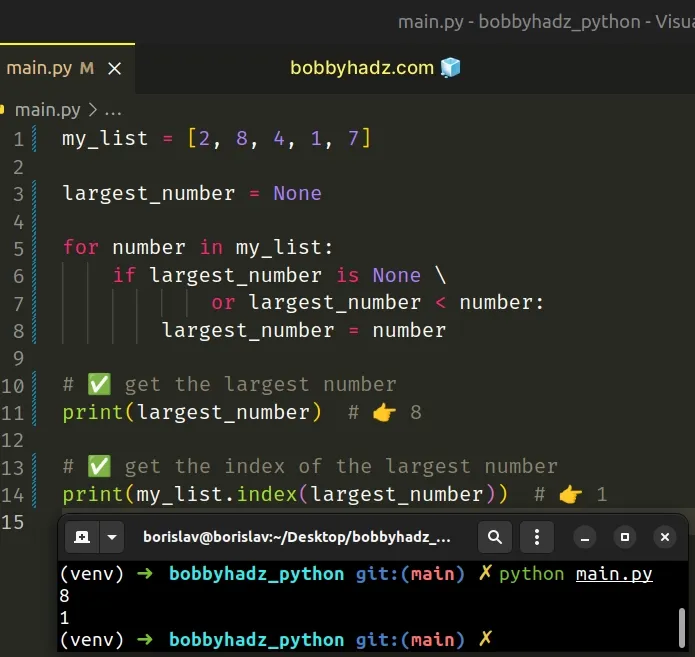
The same approach can be used to find the minimum value in a list without using
the min() function.
my_list = [4, 3, 7, 1, 9] min_number = None for number in my_list: if min_number is None or number < min_number: min_number = number # ✅ get the min value in a list print(min_number) # 👉️ 1 # ✅ get the index of the min value print(my_list.index(min_number)) # 👉️ 3
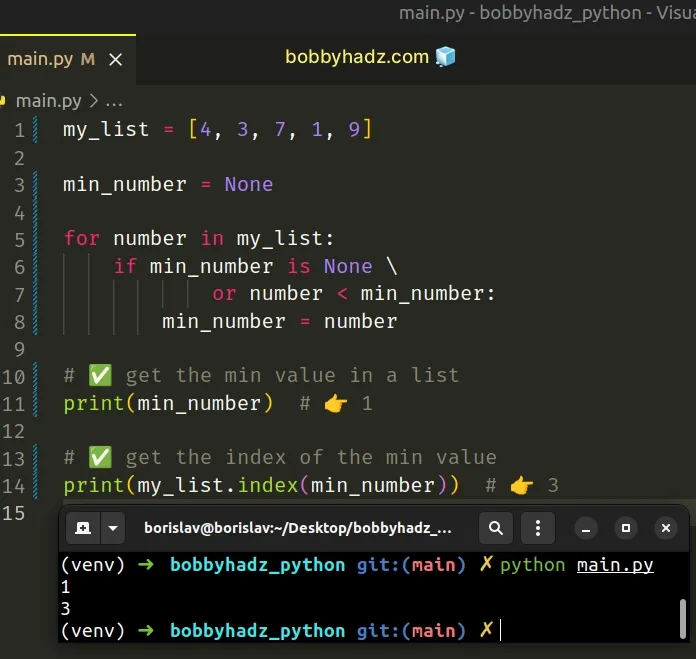
We used a for loop to iterate over the list.
largest_number variable stores a None value or is less than the current number, we reassign the variable to the number of the current iteration.After the last iteration, the largest_number variable stores the max value in
the list.
If you need to find the index of the largest number, use the list.index()
method.
my_list = [2, 8, 4, 1, 7] largest_number = None for number in my_list: if largest_number is None or largest_number < number: largest_number = number print(largest_number) # 👉️ 8 index_largest_number = my_list.index(largest_number) print(index_largest_number) # 👉️ 1

The list.index() method returns the index of the first item whose value is
equal to the provided argument.
If the list is empty, the largest_number variable remains set to None.
my_list = [] largest_number = None for number in my_list: if largest_number is None or largest_number < number: largest_number = number print(largest_number) # 👉️ None index_largest_number = ( my_list.index(largest_number) if largest_number is not None else None ) print(index_largest_number) # 👉️ None
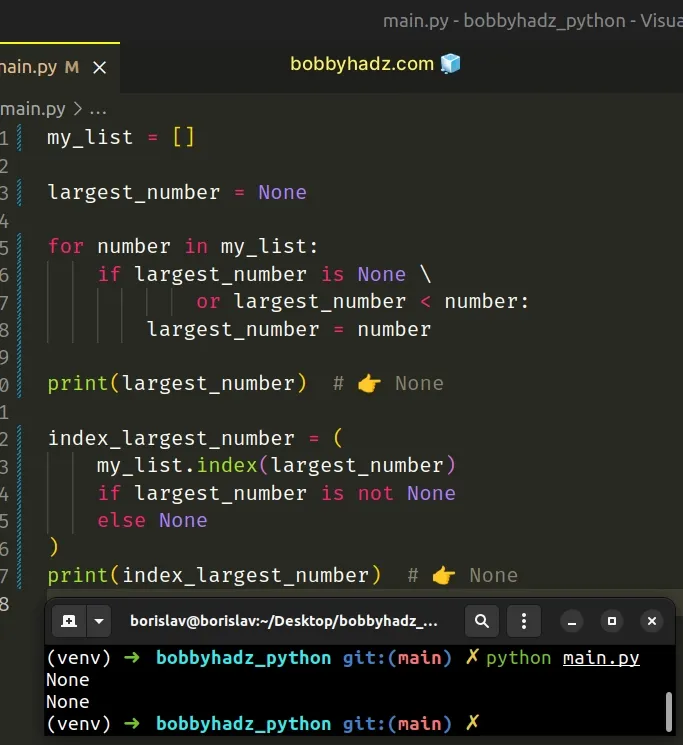
We also used an inline if/else statement when calling the list.index()
method because the method raises a ValueError if there is no such item in the
list.
Here is a reusable function that can be used to find the min and max values
in a list without the min() and
max() functions.
# Find the Min and Max in a List without min/max functions
To find the min and max values in a list without the min/max functions:
- Initialize two variables that will store the min and max values.
- Use a
forloop to iterate over the list. - Check if each number is less than
minor greater thanmax. - Update the values of the variables.
def get_min_max(l): if not l: raise ValueError('Please provide a non-empty list') minimum = maximum = l[0] for number in l[1:]: if number < minimum: minimum = number elif number > maximum: maximum = number return [minimum, maximum] print(get_min_max([2, 6, 4, 8])) # 👉️ [2, 8] print(get_min_max([6, 2, 3, 1])) # 👉️ [1, 6]
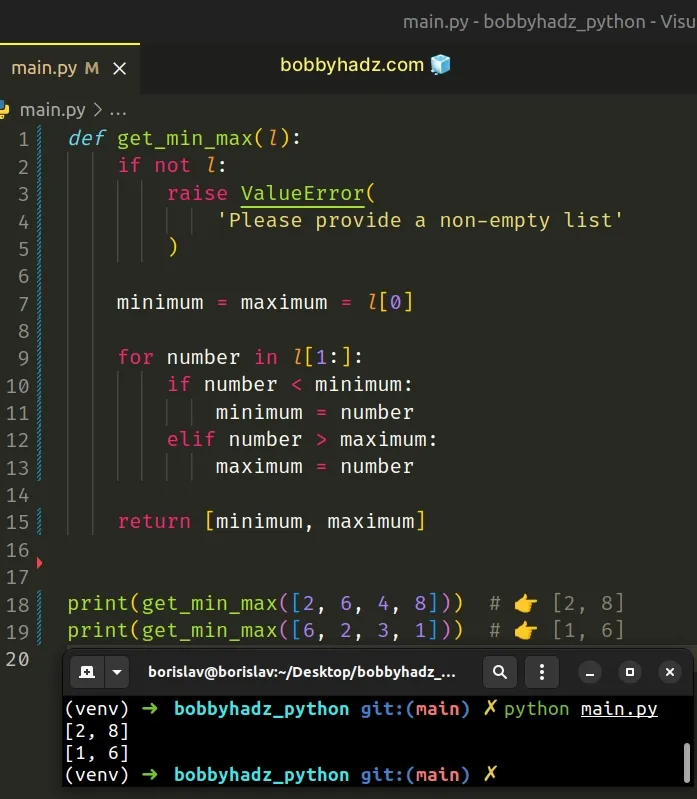
The first step is to assign the first number in the list to the minimum and
maximum variables.
We used a for loop to iterate over the rest of the list.
minimum variable.If the condition is met, we assign the number to the variable.
Otherwise, we check if the current number is greater than the value stored in
the maximum variable.
If the condition is met, we assign the number to the variable.
After the last iteration:
- the
minimumvariable stores the smallest number in the list - the
maximumvariable stores the largest number in the list
Alternatively, you can use the sorted() function.
# Find the largest number in a list without max() using sorted()
This is a three-step process:
- Use the
sorted()function to get a new sorted list. - Access the list item at index
-1. - The item at index
-1stores the largest number in the sorted list.
my_list = [2, 8, 4, 1, 7] largest_number = sorted(my_list)[-1] print(largest_number) # 👉️ 8 index_largest_number = my_list.index(largest_number) print(index_largest_number) # 👉️ 1
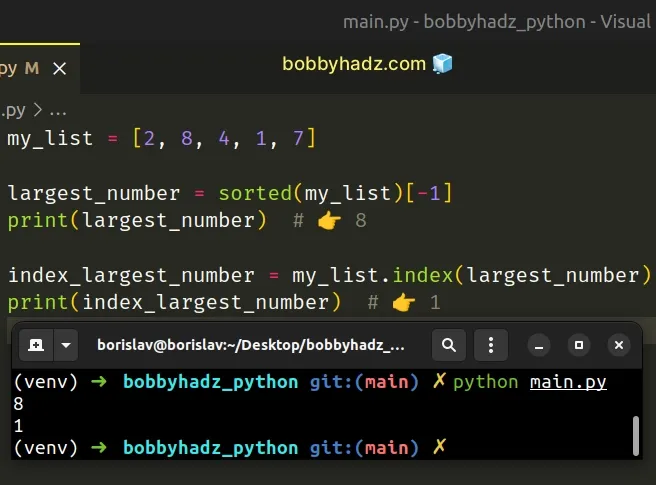
The sorted() function returns a new sorted list from the items in the iterable.
The list item at index -1 stores the largest number in the list.
Python indexes are zero-based, so the first item in a list has an index of 0,
and the last item has an index of -1 or len(my_list) - 1.
# Find the Min and Max in a List without min/max using sorted()
This is a three-step process:
- Use the
sorted()function to get a new sorted list. - Access the list item at index
0to get the min value. - Access the list item at index
-1to get the max value.
def get_min_max(l): sorted_list = sorted(l) minimum = sorted_list[0] maximum = sorted_list[-1] return [minimum, maximum] print(get_min_max([2, 6, 4, 8])) # 👉️ [2, 8] print(get_min_max([6, 2, 3, 1])) # 👉️ [1, 6]
The sorted() function returns a new sorted list from the items in the iterable.
print(sorted([2, 6, 4, 8])) # 👉️ [2, 4, 6, 8] print(sorted([2, 6, 4, 8])[0]) # 👉️ 2 print(sorted([2, 6, 4, 8])[-1]) # 👉️ 8
We accessed the list item at index 0 to get the smallest number in the list.
The list item at index -1 stores the largest number in the list.
# Additional Resources
You can learn more about the related topics by checking out the following tutorials:
- Find the indices of duplicate items in a List in Python
- Find elements in one List that are not in the other (Python)
- Find common values in multiple Lists in Python
- Find Min and Max values in Tuple or List of Tuples in Python
- Find the most/least common element in a List in Python
- Find object(s) in a List of objects in Python
- Find second Smallest or Largest number in a List in Python
- Check if a List is Sorted (ascending/descending) in Python

